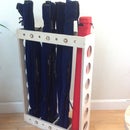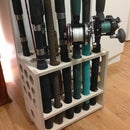Introduction: Apartment Sized Sideboard With Koi Veneer Pictorial Inlay - CNC and Laser
Most sideboards are fairly large beasts. I had a request to construct a scaled down sideboard that would fit in an apartment or small dining area. We were also going for a dramatic accent piece. The pictorial inlays were created with a laser cutter by rastering out a pocket in the door and then vector cutting the inlay out of veneer.
I was shooting for some asian cues in an overall modern design, which required some dramatic curves in the bottom rails, so I decided to cut the entire piece on the CNC router, although most of the piece could have been easily cut with a table saw.
I think the fish in the pictorial are more like mullet, but koi is what everyone else sees. I like mullet. I attempted to achieve the 3d/2d view you get when looking at fish from above the surface.
Step 1: Tools and Materials
Tools:
- CNC router with 1/4 inch compression bit
-Laser Cutter
- Pocket screw kit (jig, drill driver)
- Clothes iron (for edge banding)
- Edge band trimmer
- hand dill or drill press
-Forstner bit for euro hinge
screwdriver (electric)
- 6 foot bar clamps (4)
- 3 foot bar clamps (2)
- Paint brushes
- Finish sander
Software:
vector drawing software for inlays - i used Inkscape and Corel draw
2d cad/cam software for CNC - I did it all in Vcarve-pro
Materials:
- 3/4 plywood 2 4x8 sheets. (veneer faced - I used maple)
- 1/4 plywood - 1 sheet - for back cover (I used Luan 6mm)
- Veneer edge banding 40 ft. (veneer to match plywood)
- paper backed veneer for inlay - about 18x24 inches
- Euro hinges- frameless full overlay - 4 pieces
- Euro hinges - frameless half overlay - 2 pieces
- pocket screws mostly 1 1/4 and some 1 inch
- 220/350 grit sandpaper
- furniture finish (I used water based polyurethane)
Step 2: Plannning and Design
1. Scour the internet to determine typical dimensions for sideboards. I looked at both overall and individual dimensions (e.g. top overhang, door gap width.
2. Determined that 3 doors would be appropriate for a scaled down model meeting the overall dimension requirements, allowing a reasonable height to width ratio on the doors.
3. Purchased the hinge hardware. Use the manufacturers recommendation for gaps between doors.
4. Draw out the design for all of the parts. Ensure that the grain runs the proper direction for each part, usually the longest dimension. Ensure that the doors will fit in your laser cutter.
5. Plan the assembly of the finished piece. Where will the pocket screws go? What order should the parts be assembled?
6. Design the inlay. draw up a final version of the piece with the inlays in place. Adjust and repeat until you are satisfied.
Draw a filled in version with no line version and for rastering the pocket , and a hairline outline for cutting the veneer inlay. The inlay should be slightly larger to account for the kerf of the laser. Keep the original drawing as you will probably have to adjust at the last minute for the kerf on the day you are cutting. Here is a very good instructable on pocket laser inlay: https://www.instructables.com/id/Laser-cut-Marquetry/
Note that I prefer to cut my inlays from the back of the veneer, so I also need to mirror my vector image.
Step 3: Cutout, Edgeband, and Sand
All cuts were performed on a CNC machine with a single bit. Once the chipload and speed/feeds were calculated, the machine will do the rest. The compression bit will cut a clean edge on both sides if you make the first cut deep enough to get to the downcut spiral. The compression bits that I have found are designed for heavy production use, which means, deep cuts, high feed rates, and a firm hold-down. I could only find a single supplier (Onsrud) that publishes a recommended chipload- otherwise it is trial and error. Either way, I like to try a sample part on a scrap area of my sheet before making my official cuts.
Once the parts are cut, gently cut out any tabs and sand off any rough edges that will affect the edge banding.
Apply the edge band to part edges that will be visible after assembly. Use an iron set to the temperature recommended by the edge band manufacturer. Once cooled trim edge bands with trimmer.
Now sand all part faces and edges that will be visible after assembly.
Step 4: Add Inlay
Trial and error is important here as well. I have found that the same laser with the same materials will cut differently on consecutive days.
Use scraps of the same materials and cut a sample pocket and inlay. Adjust the kerf until you get the fit desired. With a large inlay, such as these fish, I like to add a tiny bit more gap (.001 inch) to allow for any curve that I could not get out my veneer.
I used painters tape to cover the area being rastered, and the front of the veneer to avoid any charring.
Now I hold my breath and cut the first door. The fit on the inlay was a bit too tight, so I adjusted .002 and cut again- voila!
Cut out the remaining doors.
Remove the tape, apply wood glue to the back of the veneers. press in place, wipe off any glue. Cover the door in with kitchen parchment, and clamp to another flat piece for at least one hour. Repeat for remaining doors.
Step 5: Assembly
- Use a pocket screw jig to drill out the pockets for the assembly screws. glue and clamp a side to the bottom of the top and install pocket screws. You now can remove the clamps.
-Repeat for other side, with the top rails temporarily fitted in place.
-Now install the top rails, clamping horizontally.
-Continue working your way up to the bottom of the assembly (it is upside down).
- Install the hinges on the doors. If you need to learn how to do this, there are many euro hinge tutorials on the web. I applied finish to the doors before this step to better protect the veneers.
-My local home improvement stores did not carry half overlay hinges, so I cut out some shims out of plastic on the laser cutter. This allowed me to use full overlay hinges instead.
-install the backplate with nails or small screws
Step 6: Finish
Almost done now. Touch up any scratches with sandpaper and apply the finish of your choice.
Step 7: Improvements
Design-wise, I think the overhang of the top could be smaller, the top of the doors could be higher, and the radius of the arc in the sides shorter.
On the cutting, I don't completely trust running the compression bit at the aggressive chipload recommended. I think I may switch to a combination of downcut and upcut bits to get a clean edge on both sides.
On the assembly, I think it is better to apply finish as early in the process as possible. The only issue is avoiding getting finish on areas that will be glued.
The only downside to pocket screws is that they they tend to walk and/or separate the parts during tightening. It was a bit of a pain on this project. There are pocket screw clamps (expensive) that are less unwieldy than the giant bar clamps I used, but I don't know how well they work. I think I will try using some blind mortises to assist accurate assembly on my next assembly. with the CNC router, these do not add significant time to the cut-out, and should improve assembly speed and quality.
On the laser, I will experiment with applying a layer of varnish before cutting to minimize tearout from the tape and decrease soot stains. I have seen some methods that will hold the veneer more flat as well, so I will do some trials here as well













